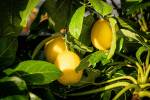Anthracnose causes minor damage
Q: In my backyard I have two Modesto ash trees about five years old. Each year the trees have developed very nicely, with full green leaves. This year, when the leaves started developing, they came out green but within a couple of weeks the coloring started getting lighter and the ends of the leaves are turning brown. Hopefully you can see this from my pictures. The trees themselves are not as full as they have been in the past.
A: I believe this is ash anthracnose that has popped up due to the cool spring weather. Leaflets show brown-to-black blotches or spots. These spots commonly start at the margin and develop to the midvein. The leaflets tend to curl toward the blighted area. Spots may also occur on the leaf tips. Infected leaves often drop prematurely, with the lowest branches usually showing the most defoliation.
Fortunately, damage from anthracnose is usually minor. A tree may lose a large portion of its foliage, but produce a second flush of leaves later in the spring. Repeated loss of leaves from the disease year after year, however, can weaken ash trees and predispose them to other diseases, insects or environmental stresses; but that seldom is a problem here.
There is no single management practice for the control of ash anthracnose. A number of fungicides are labeled for control of anthracnose, but their use is seldom justified since the disease does not seriously damage tree health. Just keep the tree healthy.
Q: I have an apricot tree. It's 5-feet tall and has stayed that height for the past four years . The tree is covered with apricots; they are very tasty but they're small. My neighbor has a peach tree. Same deal. On the other hand, I have Texas Rio grapefruit trees that are three years old, about 4 feet tall, but they make the biggest grapefruits I've ever seen. The ones I got last year were almost the size of cantaloupes. Why do some make little fruits, others giant fruits? Something about our climate? Is there some way to get bigger apricots or peaches?
A: Dwarf or small trees do not produce small fruit and large trees do not necessarily produce large fruit. The size of the fruit has to do with how you manage your fruit tree .
In fact, it is a better strategy for the fruit tree to produce lots of small fruit. It improves its chances of reproducing, which is why the fruit tree produces fruit in the first place.
The size of the fruit has more to do with the balance between the number of leaves on the tree, its general vigor and the number of fruit it has on its limbs.
The leaves and roots provide the energy and nourishment for fruit growth. The fewer number of fruits the tree has to provide for, the larger each individual fruit will become. So to get larger fruits on most trees we have to reduce the total number of fruits . To reduce the number of fruits, physically remove them from the tree when they are small, about the size of a nickel.
The distance we leave between fruits on the tree is mostly determined by the size of the fruit we want produced. Apricots are thinned, or removed, so that there is about 3 inches between fruit. Peaches may be thinned so that there is 4-6 inches between fruit .
This thinning technique allows for each of the remaining fruits to receive more energy and nutrients and get bigger. The reason your grapefruits got so big is because there weren't so many fruits on the tree compared to its number of leaves.
Q: I have an apricot tree that, year after year, provides me with wonderful fruit. However, this year there was not a single bloom and no fruit. I have no clue what is going on, it looks terrific, healthy and full but there were no blooms. The only thing that I did different this year was change fertilizers. What's up?
A: Flower production in apricots is set up the year prior to the year the fruit is produced. So 2010 apricot fruit buds really developed in mid-to-late summer of 2009. On apricots, the fruit is produced on short shoots or short branches on the limbs that we call spurs.
Some people do not realize this and prune out these short shoots thinking that the fruit will be produced on longer branches and that these spurs were just weak growth. Of course they think they are just being "tidy" in cleaning up the tree.
If this is done, then the tree will have no fruit the following year. In some cases, if we have some late freezes during flowering, the flower buds are killed and no fruit develops. This can happen with a very light freeze when the flowers are open.
Some apricots will flower before or after a freeze and the fruit will be fine but the apricot that had its flowers open on that freezing night will have no or very little fruit produced. If we have a long period of rainy weather during bloom time, then this can also affect fruit set.
Bees are needed and if the bees are not flying during inclement weather, then fruit will not set or the tree will set very few fruit. This happened to us at the University of Nevada Cooperative Extension Master Gardeners Orchard in North Las Vegas this year with one specific variety called Early Golden. It is normally a great apricot with very large fruit. This year we had hardly any fruit on this variety while others all around it had great fruit set.
If it was nothing that you did, then attribute it to a poor year for fruit set. This is one reason why producers carry crop insurance. It was not due to the fertilizer.
Bob Morris is an associate professor with the University of Nevada Cooperative Extension. Direct gardening questions to the master gardener hot line at 257-5555 or contact Morris by e-mail at morrisr@unce.unr.edu.























